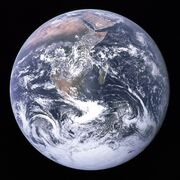
Earth is an example of a terrestrial planet.
A terrestrial planet, also known as a rocky planet, is a planet which is primarily composed of silicate rocks, or metals. In the Solar System, the terrestrial planets are the inner planets closest to the Sun, i.e Mercury, Venus, Earth, and Mars. The term 'Terrestrial planet' is derived from the Latin words for 'Earth' (Terra and Tellus), as these planets are, 'Earth-like'.
Terrestrial planets have a solid planetary surface, making them different from gas giants, which are composed mostly of some combination of hydrogen, helium, and water existing in various physical states.
Structure[]
All of the terrestrial planets in the Solar System have the same basic type of structure, such as a central metallic core, mostly iron, with a surrounding silicate mantle. The Moon is similar, but has a much smaller iron core. Io and Europa are also satellites that have internal structures similar to that of terrestrial planets. Terrestrial planets usually (but not always) have the following features: canyons, craters, mountains, volcanoes, and other surface structures, depending on the presence of water and tectonic activity. Terrestrial planets have secondary atmospheres, generated through volcanism or comet impacts, in contrast to the giant planets, whose atmospheres are primary, captured directly from the original solar nebula.